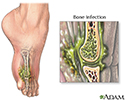Osteomyelitis
Bone infectionOsteomyelitis is a bone infection. It is caused by bacteria or other germs.
Causes
A bone infection is most often caused by bacteria. But it can also be caused by fungi or other germs. When a person has osteomyelitis:
- Bacteria or other germs may spread to a bone from infected skin, muscles, or tendons next to the bone. This may occur under a skin sore.
- The infection can start in another part of the body and spread to the bone through the blood.
- The infection can also start after bone surgery. This is more likely if the surgery is done after an injury or if metal rods or plates are placed in the bone.
In children, the long bones of the arms or legs are most often involved. In adults, the feet, spine bones (vertebrae), and hips (pelvis) are most commonly affected.
Long bones
Long bones are hard, dense bones that provide strength, structure, and mobility. The thigh bone (femur) is a long bone. A long bone has a shaft and...

Risk factors are:
-
Diabetes
Diabetes
Diabetes is a long-term (chronic) disease in which the body cannot regulate the amount of sugar in the blood.
 ImageRead Article Now Book Mark Article
ImageRead Article Now Book Mark Article -
Hemodialysis
Hemodialysis
Dialysis treats end-stage kidney disease also called kidney failure. It removes waste from your blood when your kidneys can no longer do their job. ...
 ImageRead Article Now Book Mark Article
ImageRead Article Now Book Mark Article - Poor blood supply
- Recent injury
- Use of injected illicit drugs
- Surgery involving bones
- Weakened immune system
Symptoms
Symptoms of osteomyelitis are often not specific and vary with age. Main symptoms include:
-
Bone pain
Bone pain
Bone pain or tenderness is aching or other discomfort in one or more bones.
 ImageRead Article Now Book Mark Article
ImageRead Article Now Book Mark Article - Excessive sweating
- Fever and chills
- General discomfort, uneasiness, or ill feeling (malaise)
Malaise
Malaise is a general feeling of discomfort, illness, or lack of well-being.
 ImageRead Article Now Book Mark Article
ImageRead Article Now Book Mark Article - Local swelling, redness, and warmth
Swelling
Swelling is the enlargement of organs, skin, or other body parts. It is caused by a buildup of fluid in the tissues. The extra fluid can lead to a ...
 ImageRead Article Now Book Mark Article
ImageRead Article Now Book Mark Article - Open wound that may show pus
- Pain at the site of infection
Exams and Tests
Your health care provider will examine you and ask about your symptoms. The exam may show bone tenderness and possible swelling and redness in the area around the bone.
Tests may include:
-
Blood culture
Blood culture
A blood culture is a laboratory test to check for bacteria or other germs in a blood sample.
 ImageRead Article Now Book Mark Article
ImageRead Article Now Book Mark Article -
Bone biopsy (the sample is cultured and examined under a microscope)
Bone biopsy
A bone lesion biopsy is the removal of a piece of bone or bone marrow for examination.
 ImageRead Article Now Book Mark Article
ImageRead Article Now Book Mark Article -
Bone scan
Bone scan
A bone scan is an imaging test used to diagnose bone diseases and find out how severe they are.
 ImageRead Article Now Book Mark Article
ImageRead Article Now Book Mark Article -
Bone x-ray
Bone x-ray
A bone x-ray is an imaging test to look at the bones.
 ImageRead Article Now Book Mark Article
ImageRead Article Now Book Mark Article -
Complete blood count (CBC) with differential
Complete blood count
A complete blood count (CBC) test measures the following:The number of white blood cells (WBC count)The number of red blood cells (RBC count)The numb...
 ImageRead Article Now Book Mark Article
ImageRead Article Now Book Mark ArticleDifferential
The blood differential test measures the percentage of each type of white blood cell (WBC) that you have in your blood. It also reveals if there are...
 ImageRead Article Now Book Mark Article
ImageRead Article Now Book Mark Article -
C-reactive protein (CRP)
C-reactive protein
C-reactive protein (CRP) is produced by the liver. The level of CRP rises when there is inflammation in the body. It is one of a group of proteins,...
 ImageRead Article Now Book Mark Article
ImageRead Article Now Book Mark Article -
Erythrocyte sedimentation rate (ESR)
Erythrocyte sedimentation rate
ESR stands for erythrocyte sedimentation rate. It is commonly called a "sed rate. "It is a test that indirectly measures the level of certain protei...
 ImageRead Article Now Book Mark Article
ImageRead Article Now Book Mark Article -
MRI of the bone
MRI
A magnetic resonance imaging (MRI) scan is an imaging test that uses powerful magnets and radio waves to create pictures of the body. It does not us...
 ImageRead Article Now Book Mark Article
ImageRead Article Now Book Mark Article - Needle aspiration of the area of the affected bones
Aspiration
Aspiration means to draw in or out using a sucking motion. It has two meanings:Breathing in a foreign object (for example, sucking food into the air...
 ImageRead Article Now Book Mark Article
ImageRead Article Now Book Mark Article
Treatment
The goal of treatment is to get rid of the infection and reduce damage to the bone and surrounding tissues.
Antibiotics are given to destroy the bacteria causing the infection:
- You may receive more than one antibiotic at a time.
- Antibiotics are taken for at least 4 to 6 weeks, often at home through an IV (intravenously, meaning through a vein).
At home through an IV
You or your child will be going home from the hospital soon. Your health care provider has prescribed medicines or other treatments that you or your...
 ImageRead Article Now Book Mark Article
ImageRead Article Now Book Mark Article
Surgery may be needed to remove dead bone tissue if the above methods fail:
- If there are metal plates near the infection, they may need to be removed.
- The open space left by the removed bone tissue may be filled with bone graft or packing material. This promotes resolution of the infection.
Bone graft
A bone graft is surgery to place new bone or bone substitutes into spaces around a broken bone or bone defects to stimulate healing.
 ImageRead Article Now Book Mark Article
ImageRead Article Now Book Mark Article
Infection that occurs after joint replacement may require surgery. This is done to remove the replaced joint and infected tissue in the area. A new prosthesis may be implanted in the same operation. More often, providers wait until the antibiotic course is finished and the infection has gone away.
Prosthesis
A prosthesis is a device designed to replace a missing part of the body or to make a part of the body work better. Diseased or missing eyes, arms, h...

If you have diabetes, it will need to be well controlled. If there are problems with blood supply to the infected area, such as the foot, surgery may be needed to improve blood flow in order to get rid of the infection.
Diabetes
Diabetes is a long-term (chronic) disease in which the body cannot regulate the amount of sugar in the blood.

Problems with blood supply
Peripheral artery disease (PAD) is a condition of the blood vessels that supply the legs and feet. It occurs due to narrowing of the arteries in the...

Outlook (Prognosis)
With treatment, the outcome for acute osteomyelitis is often good.
The outlook is worse for those with long-term (chronic) osteomyelitis. Symptoms may come and go for years, even with surgery. Amputation may be needed, especially in people with diabetes or poor blood circulation.
Chronic
Chronic refers to something that continues over an extended period of time. A chronic condition is usually long-lasting and does not easily or quick...

The outlook for people with an infection of a prosthesis depends partly on:
- The person's health
- The type of infection
- Whether the infected prosthesis can be safely removed
When to Contact a Medical Professional
Contact your provider if you:
- Develop symptoms of osteomyelitis
- Have osteomyelitis that continues even with treatment
References
Matteson EL, Osmon DR. Infections of bursae, joints, and bones. In: Goldman L, Cooney KA, eds. Goldman-Cecil Medicine. 27th ed. Philadelphia, PA: Elsevier; 2024:chap 251.
Raukar NP, Zink BJ. Bone and joint infections. In: Walls RM, ed. Rosen's Emergency Medicine: Concepts and Clinical Practice. 10th ed. Philadelphia, PA: Elsevier; 2023:chap 125.
Tande AJ, Steckelberg JM, Osmon DR, Berbari EF. Osteomyelitis. In: Bennett JE, Dolin R, Blaser MJ, eds. Mandell, Douglas, and Bennett's Principles and Practice of Infectious Diseases. 9th ed. Philadelphia, PA: Elsevier; 2020:chap 104.
-
X-ray - illustration
X-rays are a form of ionizing radiation that can penetrate the body to form an image on film. Structures that are dense (such as bone) will appear white, air will be black, and other structures will be shades of gray depending on density. X-rays can provide information about obstructions, tumors, and other diseases, especially when coupled with the use of barium and air contrast within the bowel.
X-ray
illustration
-
Skeleton - illustration
The skeleton consists of groups of bones which protect and move the body.
Skeleton
illustration
-
Osteomyelitis - illustration
Osteomyelitis is infection in the bones. Often, the original site of infection is elsewhere in the body, and spreads to the bone by the blood. Bacteria or fungus may sometimes be responsible for osteomyelitis.
Osteomyelitis
illustration
-
Bacteria - illustration
Bacterial infections can lead to the formation of pus, or to the spread of the bacteria in the blood.
Bacteria
illustration
-
X-ray - illustration
X-rays are a form of ionizing radiation that can penetrate the body to form an image on film. Structures that are dense (such as bone) will appear white, air will be black, and other structures will be shades of gray depending on density. X-rays can provide information about obstructions, tumors, and other diseases, especially when coupled with the use of barium and air contrast within the bowel.
X-ray
illustration
-
Skeleton - illustration
The skeleton consists of groups of bones which protect and move the body.
Skeleton
illustration
-
Osteomyelitis - illustration
Osteomyelitis is infection in the bones. Often, the original site of infection is elsewhere in the body, and spreads to the bone by the blood. Bacteria or fungus may sometimes be responsible for osteomyelitis.
Osteomyelitis
illustration
-
Bacteria - illustration
Bacterial infections can lead to the formation of pus, or to the spread of the bacteria in the blood.
Bacteria
illustration
Review Date: 3/16/2024
Reviewed By: Jatin M. Vyas, MD, PhD, Roy and Diana Vagelos Professor in Medicine, Columbia University Vagelos College of Physicians and Surgeons, Division of Infectious Diseases, Department of Medicine, New York, NY. Also reviewed by David C. Dugdale, MD, Medical Director, Brenda Conaway, Editorial Director, and the A.D.A.M. Editorial team.





